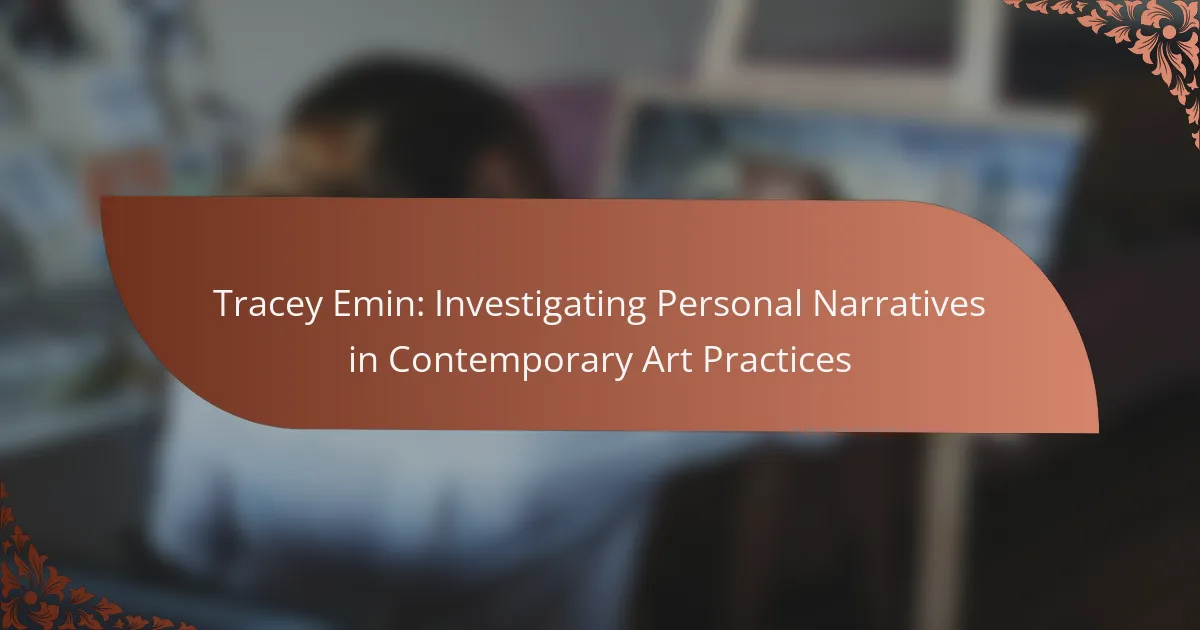Tracey Emin’s art challenges viewers to confront their own personal narratives through her exploration of trauma, intimacy, and identity. Her diverse mediums, including drawing, sculpture, and textiles, enhance the emotional depth of her work. Emin’s evolution from confessional art to broader themes of resilience reflects her journey as an artist. Her provocative pieces invite both reflection and dialogue, making her a significant figure in contemporary art discussions.
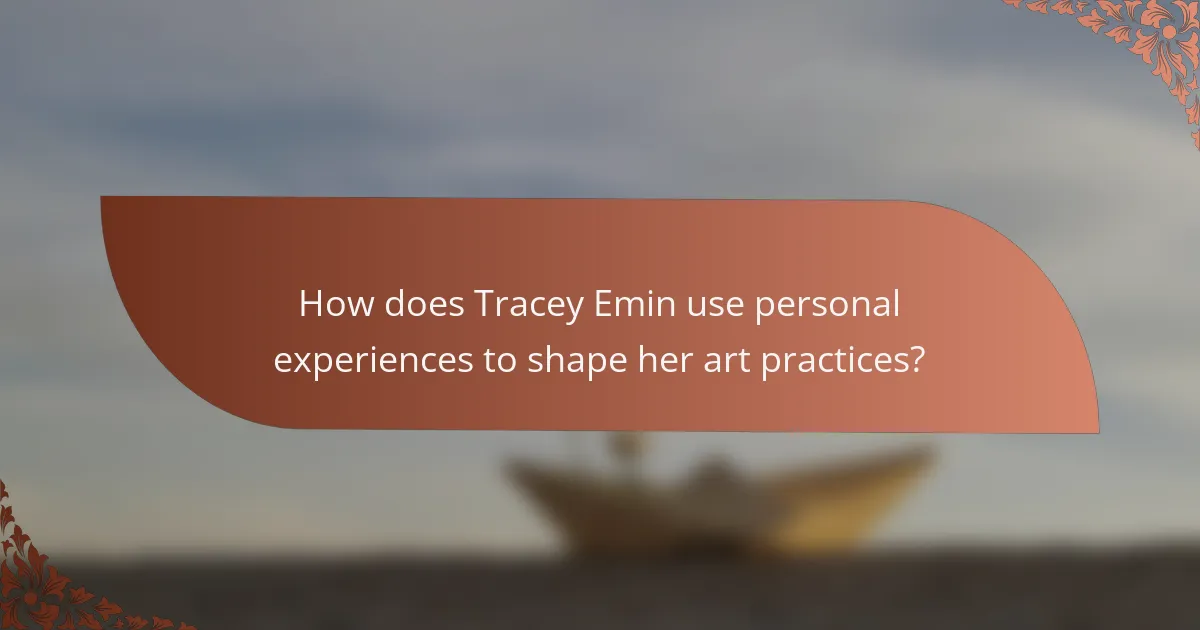
How does Tracey Emin use personal experiences to shape her art practices?
Tracey Emin uses personal experiences as a foundation for her art, creating deeply emotional and autobiographical works. Her unique attribute lies in her ability to transform trauma and intimacy into visual narratives. Emin’s art often reflects themes of love, loss, and identity, making her experiences relatable to a wide audience. For example, her installations and drawings frequently incorporate elements from her life, such as her childhood and relationships, enhancing the authenticity of her expression. This approach not only shapes her artistic practice but also invites viewers to engage with their own personal narratives.
What themes emerge from Emin’s autobiographical narratives?
Tracey Emin’s autobiographical narratives reveal themes of trauma, vulnerability, and resilience. Her works often explore personal experiences, emotional honesty, and the complexities of female identity. Emin’s unique approach to storytelling through art challenges societal norms and invites viewers to confront uncomfortable truths. This exploration of self and memory fosters a deeper understanding of human connection and healing.
How do her life events influence her artistic expression?
Tracey Emin’s life events profoundly shape her artistic expression, reflecting personal trauma, relationships, and experiences. Her work often incorporates autobiographical elements, allowing viewers to engage with her emotional landscape. For instance, Emin’s piece “My Bed” embodies vulnerability and intimacy, showcasing her struggles with mental health and personal relationships. This unique attribute of her art invites audiences to confront their own narratives, establishing a deep connection between her life and her creative output. Emin’s ability to transform personal pain into art highlights the power of storytelling in contemporary practices.

What are the key mediums employed by Tracey Emin in her work?
Tracey Emin employs a variety of mediums in her work, including drawing, painting, sculpture, and installation. Her use of textiles, particularly in her famous quilts, showcases her unique approach to personal narrative. Emin also utilizes neon lights to convey emotional depth and direct messages. Additionally, she incorporates video and performance art, enhancing the intimacy of her storytelling. Each medium reflects her exploration of personal experiences and relationships, making her work deeply resonant.
How does Emin’s use of textiles reflect her personal narrative?
Tracey Emin’s use of textiles powerfully conveys her personal narrative through tactile engagement and emotional expression. Textiles serve as a medium for storytelling, reflecting her experiences of trauma, love, and identity. For example, her embroidered works often incorporate intimate messages and personal symbols, creating a direct connection to her life history. This approach adds a unique attribute to her art, as it transforms ordinary materials into poignant reflections of her inner world. Emin’s textiles invite viewers to explore the complexities of her narrative, making her work resonate on a deeply personal level.
What role does installation art play in her storytelling?
Installation art plays a crucial role in Tracey Emin’s storytelling by creating immersive experiences that convey her personal narratives. Through her installations, Emin engages viewers emotionally and invites them to explore themes of memory, trauma, and identity. The unique attribute of her work lies in the use of personal objects and spaces, transforming them into powerful symbols of her life experiences. This approach allows for a rare intimacy, fostering a deeper connection between the audience and her stories. Emin’s installations serve as a canvas for her reflections, making abstract emotions tangible and accessible.
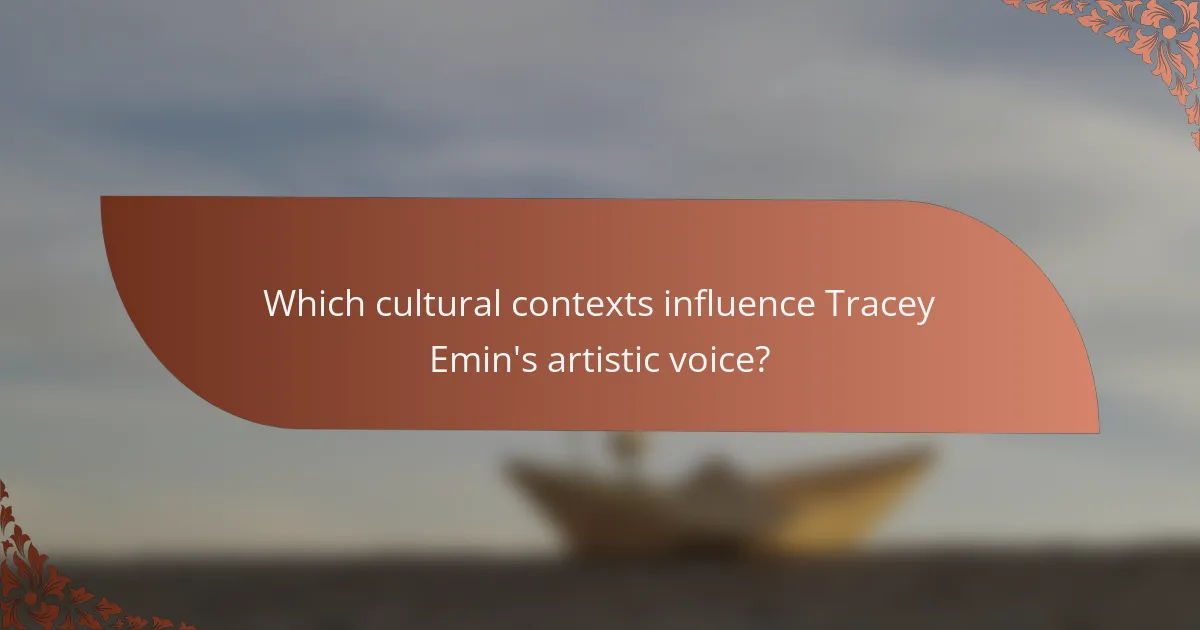
Which cultural contexts influence Tracey Emin’s artistic voice?
Tracey Emin’s artistic voice is influenced by personal experiences, cultural heritage, and societal contexts. Her work often reflects themes of vulnerability, trauma, and femininity, shaped by her upbringing in Margate, England. Emin’s exploration of personal narratives connects to broader cultural movements, including feminism and confessional art. This intersection of the personal and political enhances the emotional depth of her pieces, making her a significant figure in contemporary art.
How does Emin’s work resonate within the UK art scene?
Tracey Emin’s work profoundly resonates within the UK art scene through its exploration of personal narratives. Emin’s art embodies raw emotional honesty, often drawing from her own experiences, which challenges traditional boundaries in contemporary art. Her unique attribute of utilizing autobiographical elements creates a strong connection with audiences, inviting them to engage with their own stories. Emin’s influence is evident in the rise of artists who similarly prioritize personal expression, making her a pivotal figure in shaping contemporary art practices in the UK.
What are the global implications of her narratives?
Tracey Emin’s narratives have significant global implications, influencing discussions on identity and trauma. Her work challenges societal norms and invites dialogue on personal experiences within broader cultural contexts. Emin’s art promotes empathy and understanding, fostering connections across diverse audiences. This impact extends beyond individual interpretation, shaping contemporary art practices and highlighting the importance of personal storytelling in addressing collective issues.
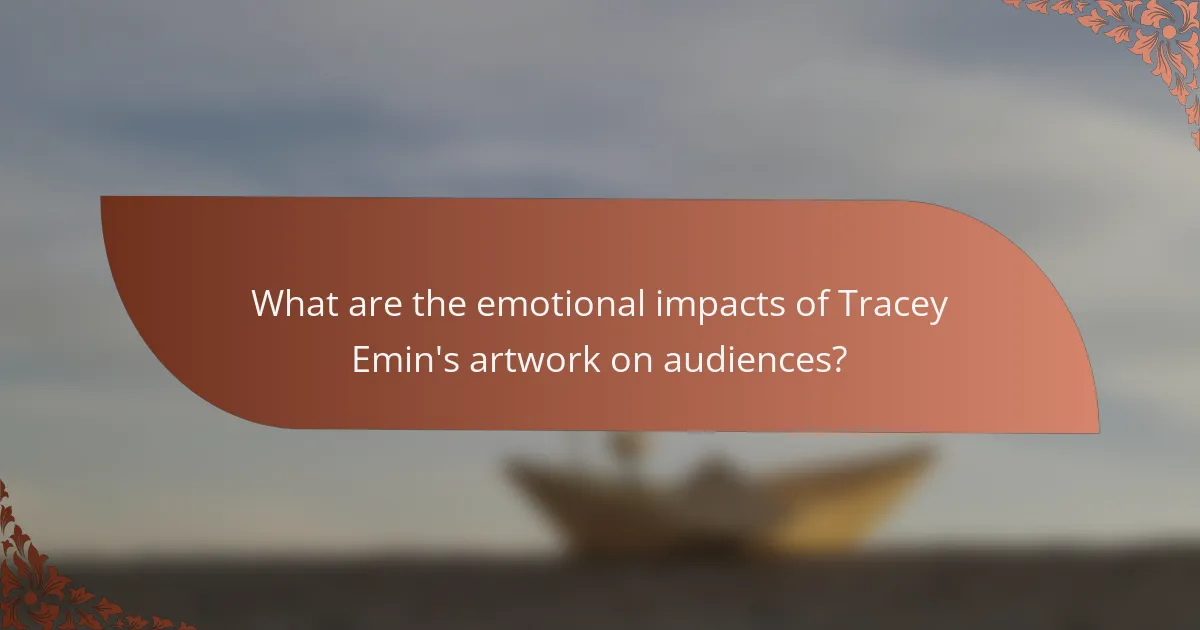
What are the emotional impacts of Tracey Emin’s artwork on audiences?
Tracey Emin’s artwork evokes profound emotional responses, often eliciting feelings of vulnerability and introspection. Her personal narratives resonate with audiences, prompting reflections on their own experiences. Emin’s unique approach to themes like love, loss, and trauma creates a visceral connection, making her work impactful. The raw honesty in her pieces allows viewers to confront their emotions, fostering a sense of shared humanity.
How do viewers interpret vulnerability in her pieces?
Viewers interpret vulnerability in Tracey Emin’s pieces as an authentic expression of personal struggles and emotional depth. Her work often reflects raw honesty, inviting audiences to connect with their own experiences of pain and resilience. Emin’s unique attribute lies in her ability to transform personal trauma into relatable art, creating a space for empathy and reflection. This approach encourages viewers to confront their vulnerabilities, fostering a deeper understanding of human emotions.
What responses do her works elicit in various cultural settings?
Tracey Emin’s works evoke a spectrum of emotional responses across cultural settings, often challenging societal norms. Her art elicits empathy, discomfort, and introspection, reflecting personal narratives that resonate universally. In Western contexts, her themes of vulnerability and trauma foster dialogue on mental health. Conversely, in more conservative cultures, her candid expressions may provoke controversy, highlighting differing values around personal storytelling. Emin’s unique ability to navigate these varied reactions underscores the power of personal narrative in contemporary art.
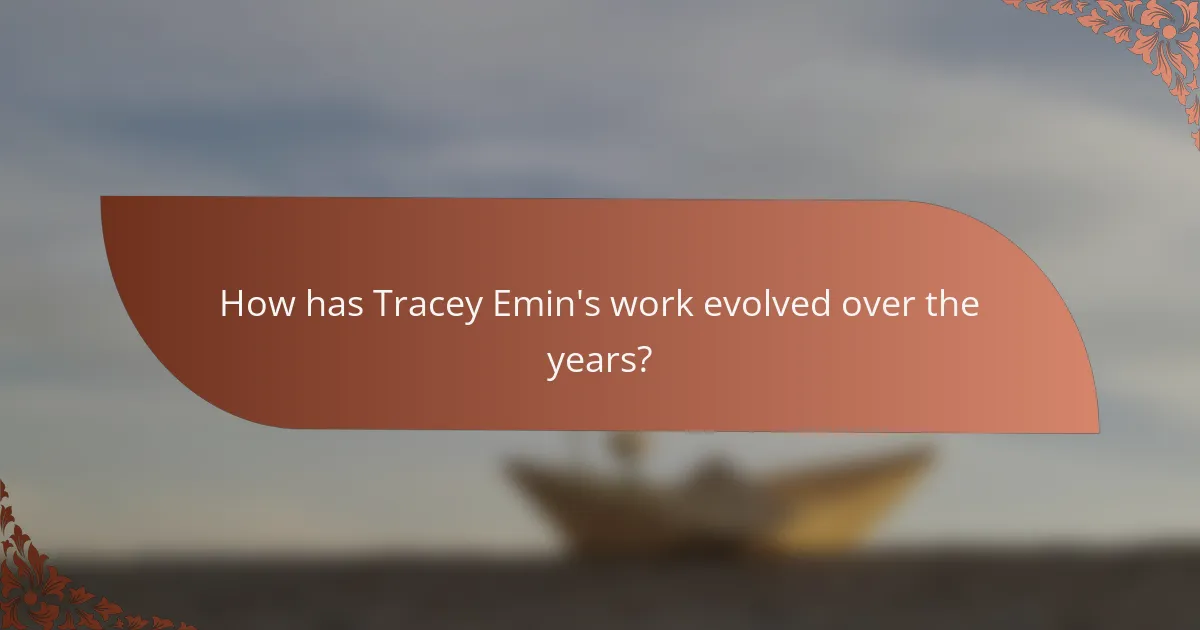
How has Tracey Emin’s work evolved over the years?
Tracey Emin’s work has evolved from confessional art to broader themes of identity and resilience. Initially, her pieces focused on personal experiences, often expressing vulnerability and emotional turmoil. Over time, she has incorporated diverse mediums, expanding her narrative scope to include collective experiences and societal issues. Emin’s later works reflect a unique attribute of resilience, showcasing strength in vulnerability. This evolution illustrates her journey as an artist, continually redefining her relationship with personal and public narratives.
What are the significant milestones in her artistic journey?
Tracey Emin’s artistic journey includes significant milestones that highlight her evolution as a contemporary artist. Key events include her 1997 Turner Prize nomination for “My Bed,” which showcased her personal narrative and emotional vulnerability. In 2005, she represented Britain at the Venice Biennale, further establishing her international presence. Emin’s 2011 exhibition “Love is What You Want” at the Hayward Gallery explored themes of love and loss, reinforcing her unique approach to autobiographical art. In 2016, she was appointed a professor at the Royal Academy of Arts, marking her influence on future generations of artists. Each milestone reflects her commitment to expressing personal experiences through diverse mediums.
How does her recent work reflect changes in personal perspective?
Tracey Emin’s recent work showcases a profound evolution in her personal perspective, emphasizing vulnerability and introspection. Her latest pieces reflect an exploration of trauma and healing, revealing deeper emotional narratives. This shift highlights her unique ability to transform personal experiences into universal themes, resonating with a broader audience. Emin’s art now serves as a platform for dialogue about mental health and personal identity, marking a significant change in her artistic approach.
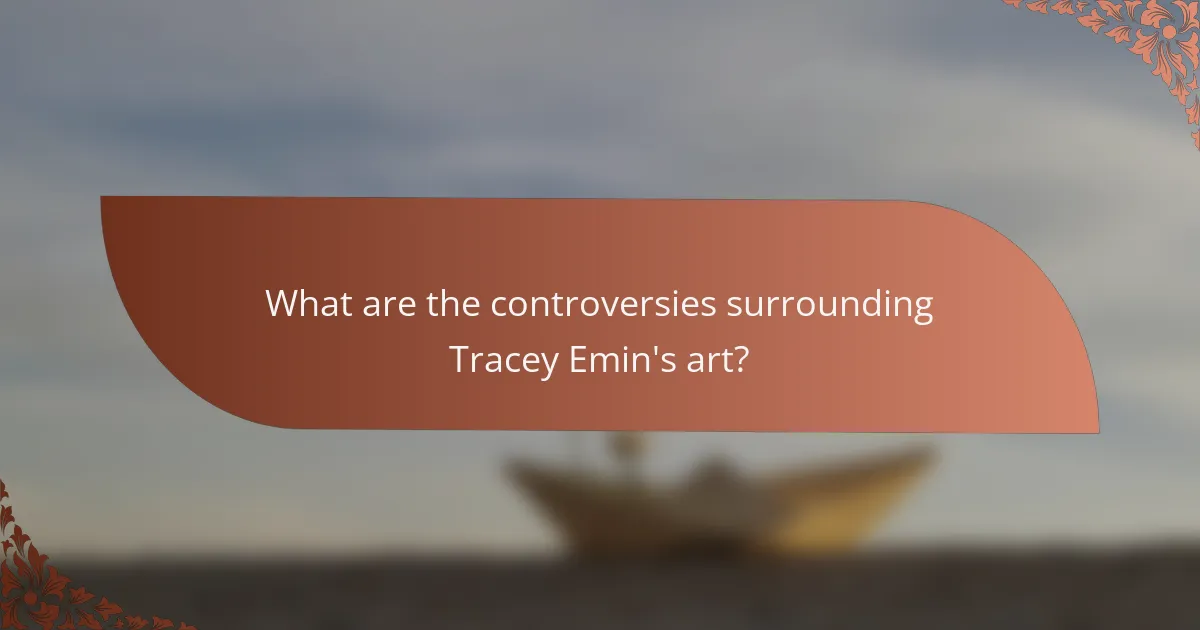
What are the controversies surrounding Tracey Emin’s art?
Tracey Emin’s art often sparks controversy due to its raw exploration of personal trauma and sexuality. Critics argue that her work blurs the line between art and autobiography, challenging traditional artistic boundaries. Emin’s provocative pieces, such as “My Bed,” evoke strong emotional responses, leading to debates about the nature of art and its societal impact. Additionally, her candid approach to sensitive topics can alienate some audiences while resonating with others, highlighting the polarizing effect of personal narratives in contemporary art.
How do critics perceive her use of explicit content?
Critics often perceive Tracey Emin’s use of explicit content as a bold exploration of personal trauma and vulnerability. Her work challenges societal norms and provokes discussions about the boundaries of art. Emin’s unique attribute lies in her ability to transform intimate experiences into powerful visual narratives, which some critics view as a cathartic process. Others argue that her explicitness risks alienating audiences, yet many acknowledge its authenticity and emotional resonance. This duality in perception highlights the complexity of her artistic approach and its impact on contemporary art discourse.
What role does feminism play in the critique of her work?
Feminism plays a significant role in critiquing Tracey Emin’s work by emphasizing personal experiences and societal norms. Her art often reflects themes of female identity, trauma, and empowerment. Feminist critiques highlight how Emin’s narratives challenge traditional gender roles and explore the complexities of women’s experiences. This perspective encourages deeper engagement with the emotional and psychological dimensions of her art, showcasing its impact on contemporary feminist discourse. Emin’s unique approach to storytelling through her art invites discussions on the intersection of personal and political, reinforcing her position within feminist art movements.
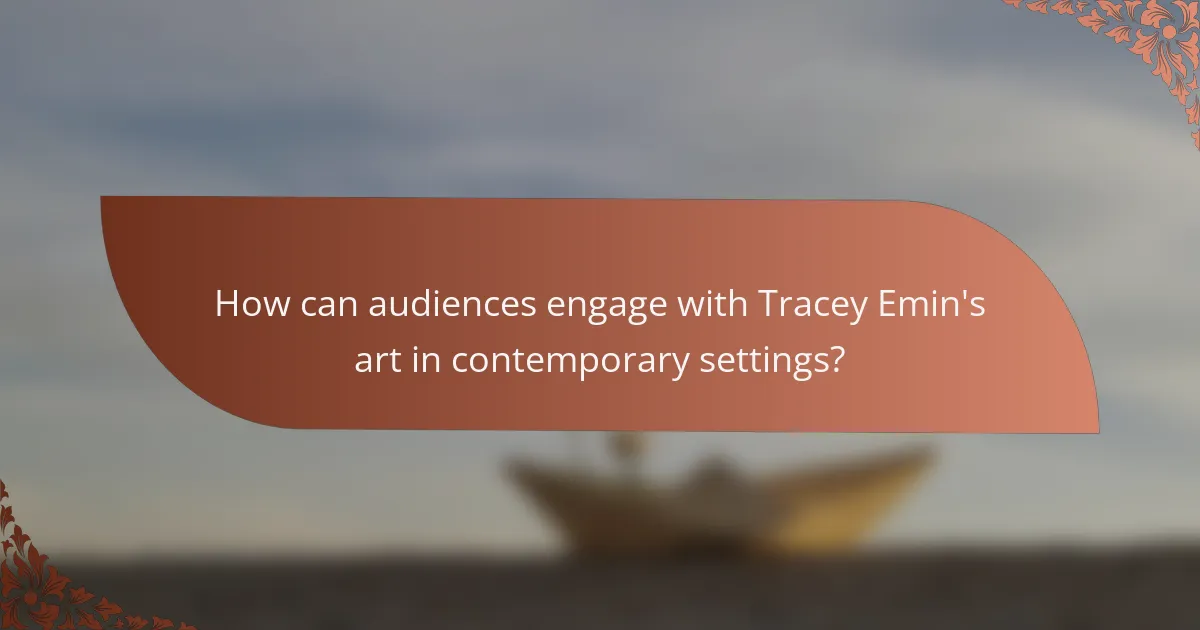
How can audiences engage with Tracey Emin’s art in contemporary settings?
Audiences can engage with Tracey Emin’s art through immersive experiences, workshops, and digital platforms. Emin’s work often invites personal reflection and dialogue, making it accessible in various contemporary settings.
Exhibitions frequently include interactive elements that encourage viewer participation. For instance, Emin’s installations may feature spaces for visitors to write their own stories, fostering a sense of connection.
Online platforms allow for broader engagement. Virtual tours and social media discussions enable audiences to explore Emin’s themes of vulnerability and identity from anywhere.
Collaborative projects with local communities also enhance engagement. These initiatives can create shared narratives that resonate with Emin’s focus on personal experiences and societal issues.
What are the best practices for experiencing her installations?
To experience Tracey Emin’s installations effectively, engage with the personal narratives presented. Embrace the emotional depth and vulnerability inherent in her work. Consider visiting during quieter hours for a more introspective experience. Take time to reflect on your personal connections to the themes of love, loss, and identity. Document your thoughts and feelings to deepen your understanding.
How can her narratives inspire personal reflection and dialogue?
Tracey Emin’s narratives encourage personal reflection and dialogue by evoking raw emotions and shared experiences. Her art often explores themes of vulnerability, identity, and trauma, prompting viewers to confront their own feelings. By presenting her life stories candidly, Emin invites audiences to engage in meaningful conversations about their personal journeys. This connection fosters a deeper understanding of both individual and collective human experiences.
What common mistakes should be avoided when interpreting her work?
Common mistakes to avoid when interpreting Tracey Emin’s work include oversimplifying her personal narratives, neglecting the emotional depth, and failing to consider the context of her experiences. Many viewers misinterpret her raw expression as mere shock value rather than a profound exploration of identity and trauma. Additionally, overlooking the interplay between her art and autobiographical elements can lead to a superficial understanding. Lastly, not acknowledging the cultural and feminist implications of her work can result in a limited perspective on her contributions to contemporary art.
